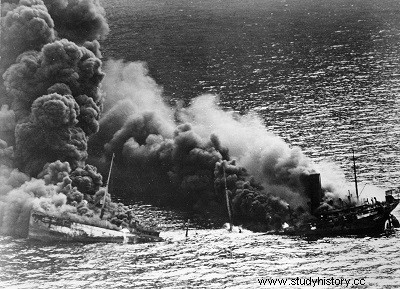
The English Admiralty knew that several hundred new submarines were in construction. The number already existing was therefore tiny compared to that of those who were to arrive. Before the war, in a book on submarine warfare, Admiral Donitz had estimated that 300 more submarines would be needed to win the war against England. This meant a total force of 900 submarines, taking into account possible losses, crew training and rest periods, repairs, etc. This book, of course, had been read by many English naval officers. None of them doubted that the Germans could reach this figure. In addition, Hitler had declared, on August 17, his intention to organize a total blockade of the British Isles. By warning that all neutral ships would be sunk, he made it clear that it was by means of this submarine campaign that he intended to win his war.
By 1940, the Germans had lost 22 U-boats, although at the time the English Admiralty had knowledge of only 16 confirmed cases, the other 6 having been sunk by accident or for unknown causes. Compared to the German construction program, this “exchange rate” was hardly satisfactory. Over the whole year, it proved that for every submarine lost, about 100,000 tons of Allied shipping had been sunk. England and her allies had to outdo each other if they were to win the Battle of the Atlantic, on which the outcome of the war depended.
A great hope loomed. During the year, the limits of the escorts had been pushed further into the Atlantic. As soon as the base in Iceland is in working order, an even bigger step could be taken. New escort ships were beginning to be put into service. The time was not far off when convoys could be escorted the full length of the ocean. Convoys, the Admiralty knew, had defeated submarines in 1917 and 1918. Once again, in London, it was expected to be so.
If submarines had been the only cause of merchant shipping losses, it would not have been too difficult to contain them. But many losses were due to different causes. The German air force, operating mainly against the coastal convoys of the east coast and the English Channel, sank, in 1940, 192 ships of a total of 580,000 tons. The mines, during the same year, claimed 201 ships (510,000 tons), while the torpedo boats claimed 23 ships for a total of 48,000 tons. Most of these sunken boats were relatively small. They were intended for the coastal trade, therefore more easily and more quickly replaced by new constructions. Put together, however, their total losses exceeded one million tons.
